Asus ROG Swift PG32UQ 32" Monitor Review
Earlier this twelvemonth nosotros reviewed the Asus ROG Swift PG32UQX, a $3,000 animal of a monitor packing 32-inch 4K 144Hz specs along with full HDR functionality. It's one of the best HDR gaming monitors yous tin buy today, merely it still felt compromised in other aspects, especially for a product that costs a few grand bucks. But for those that won't spent the price of two LG OLED TVs to spend on a single gaming monitor, Asus has an culling monitor that we're looking at today.
The ROG PG32UQ -- basically the non-X variant -- is the aforementioned blazon of monitor at 32-inch 4K 144Hz IPS, intended for high end gaming with features like adaptive sync and variable overdrive. Instead of providing total HDR through a 1152-zone mini-LED backlight, Asus has opted for a lower toll edge-lit HDR setup giving us DisplayHDR 600 instead of 1400.
This along with the removal of the G-Sync module in favor of a regular display scaler, has shaved off a whopping $2,000 from the price tag.
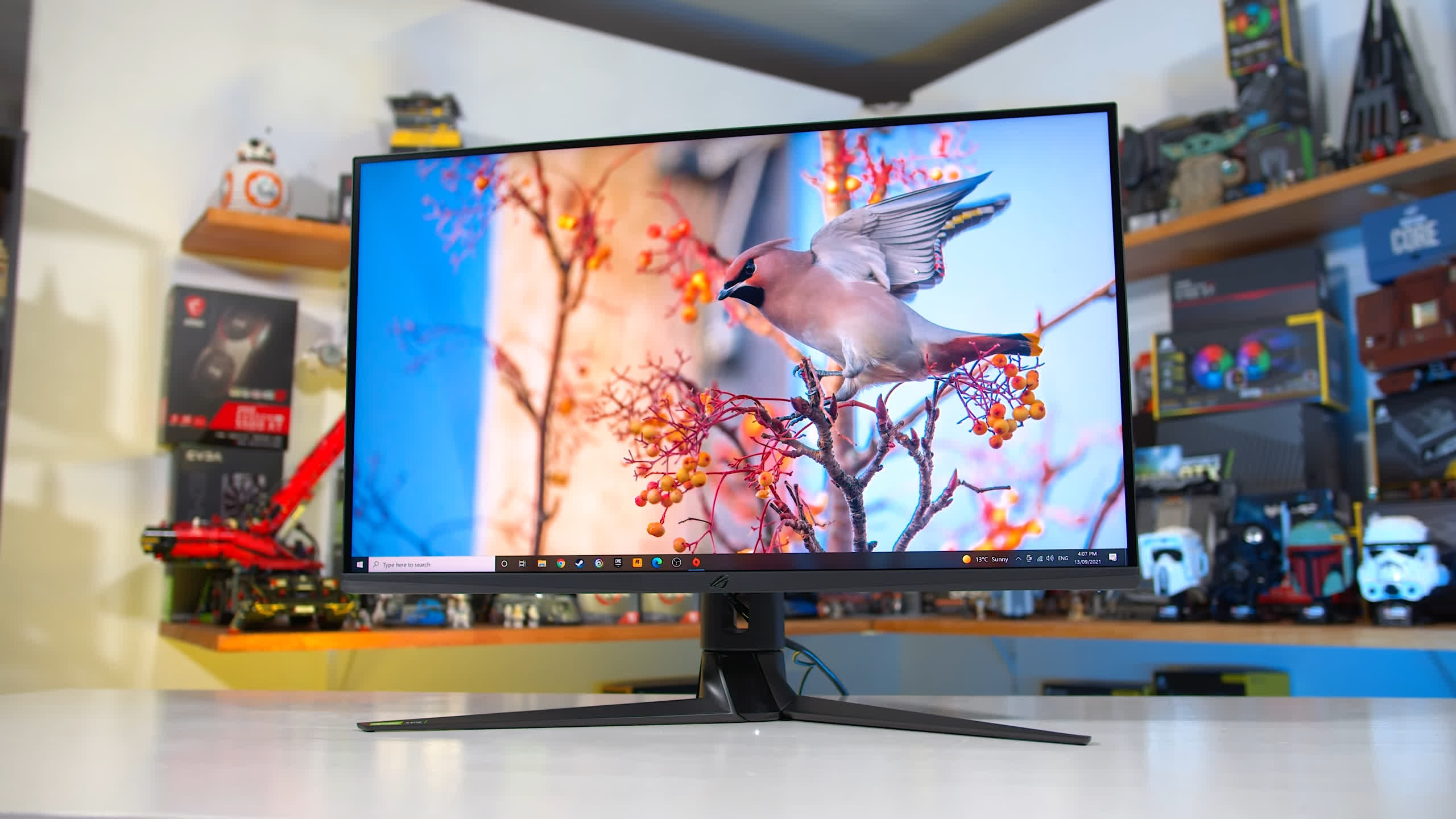
The PG32UQ remains a high-end gaming monitor that will prepare you dorsum $1,000. Only compared to other similar displays on the marketplace, that'due south not an outrageous price tag and is certainly going to exist more tempting than the $3,000 PG32UQX for anyone simply high rollers.
Just it's not simply the price tag that makes the PG32UQ potentially the more attractive buy. This display features HDMI ii.1, so you can hook it up to both PCs and the latest game consoles and get a full 120Hz or 144Hz feel without bandwidth limitations.
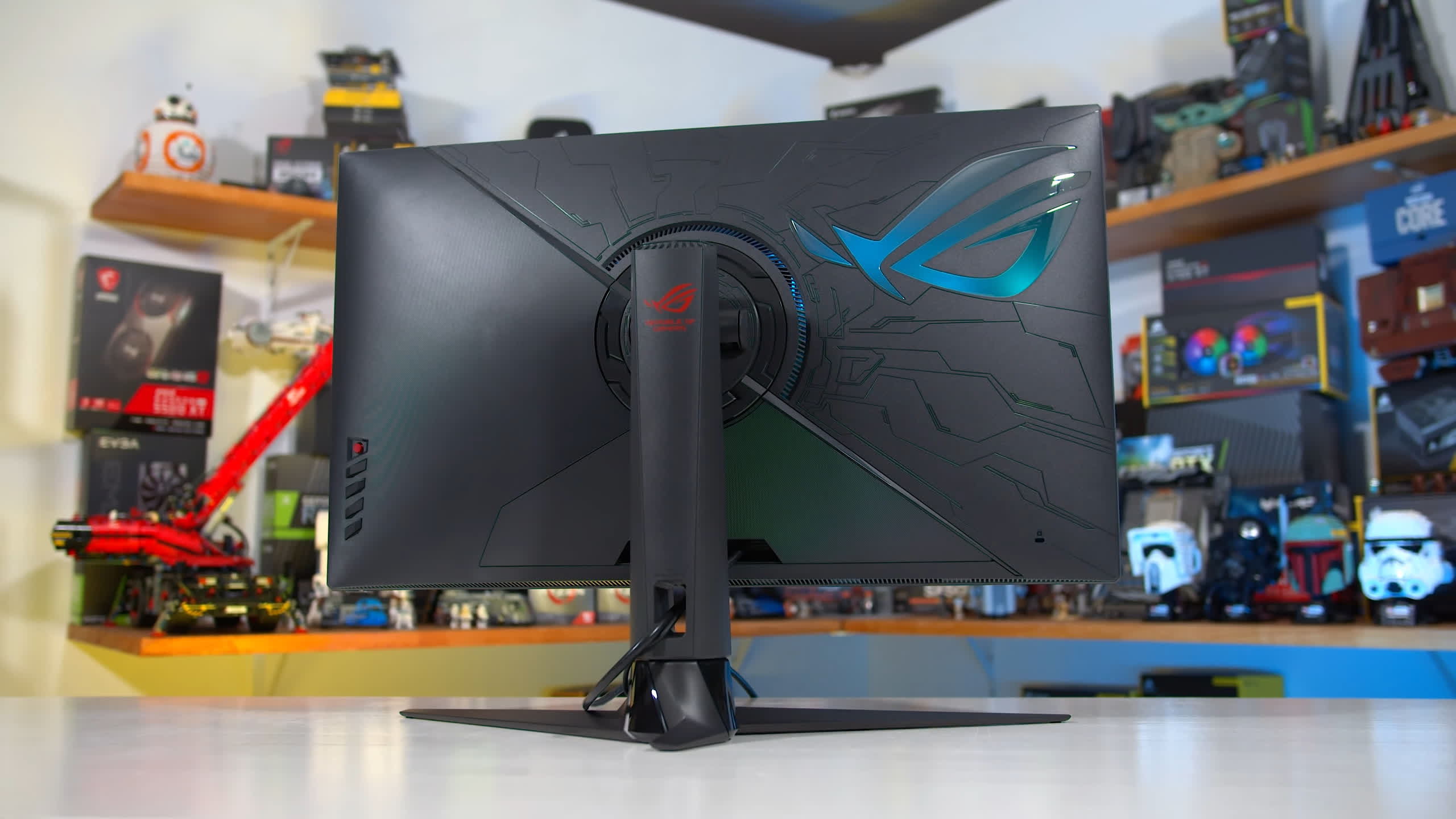
This is a central feature of a modernistic 4K high refresh monitor, and annoyingly the more than expensive PG32UQX doesn't include HDMI 2.1 which limits its usability with the Xbox Serial X and PlayStation five. No such issues with the more affordable PG32UQ, which is kind of an oddity in Asus' line-upwards. You get two HDMI 2.i ports and a DisplayPort 1.iv with DSC.
Blueprint and Form Factor
The overall design is... well... we've seen this before. If you've seen any other recent Asus ROG monitor, y'all'll know what nosotros're in for here. Three-pronged metal stand legs which look nice and experience premium, then the rest of the monitor is basically standard plastic with the usual ROG gamer mode. Big RGB LED logo on the dorsum equally well.
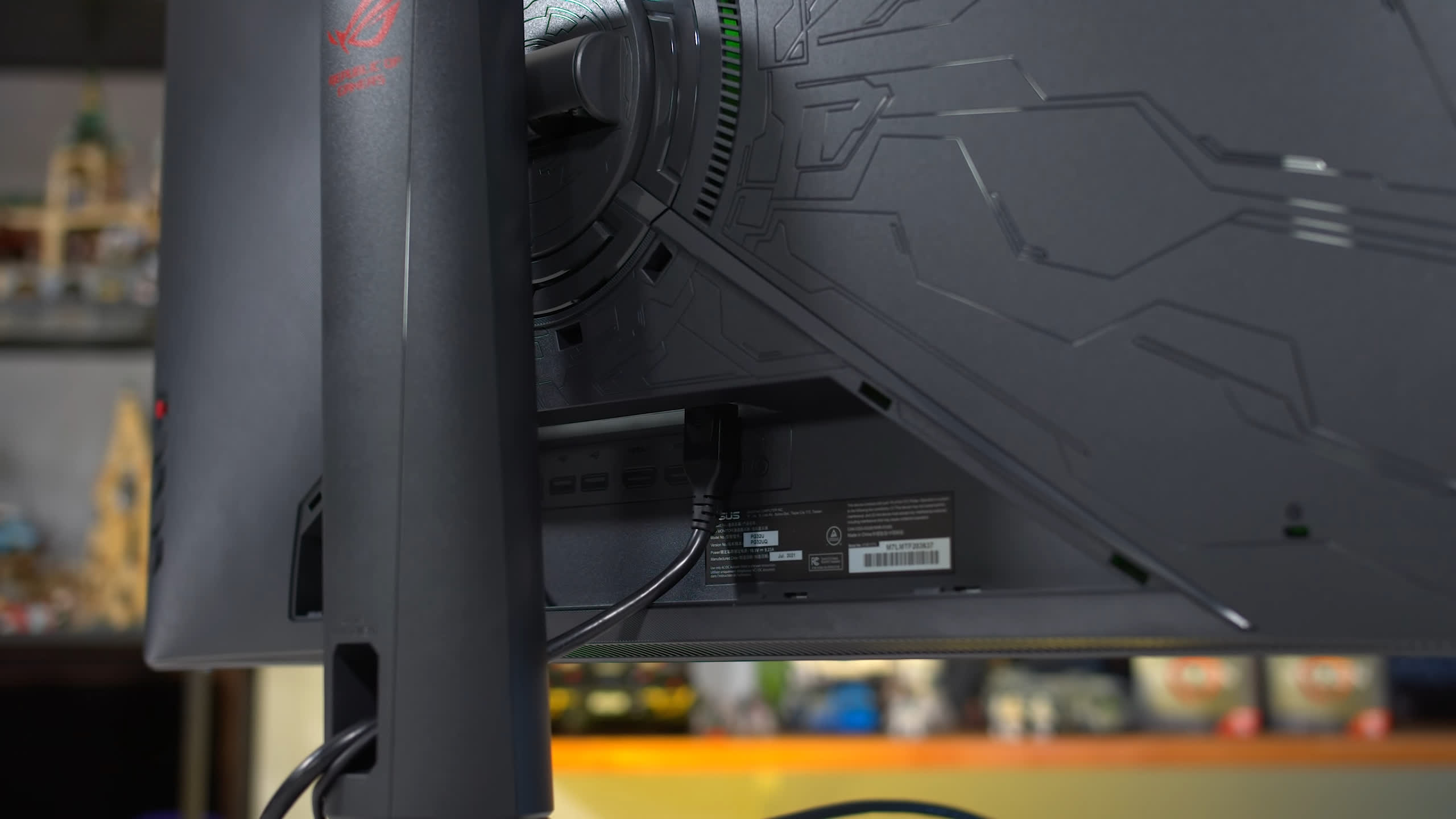
I've said before that I'm non a large fan of Asus designs and would personally prefer a cleaner aesthetic on the rear, still from the forepart – the side well-nigh people will actually see – it looks fine.
If anything, it'southward a small comeback on prior monitors as Asus has replaced the copper highlights on the stand with blackness, creating a more neutral color palette that volition work better with more than setups. It's still a gamer-styled monitor and it'southward clearly liked by many every bit Asus does sell a ton of monitors.
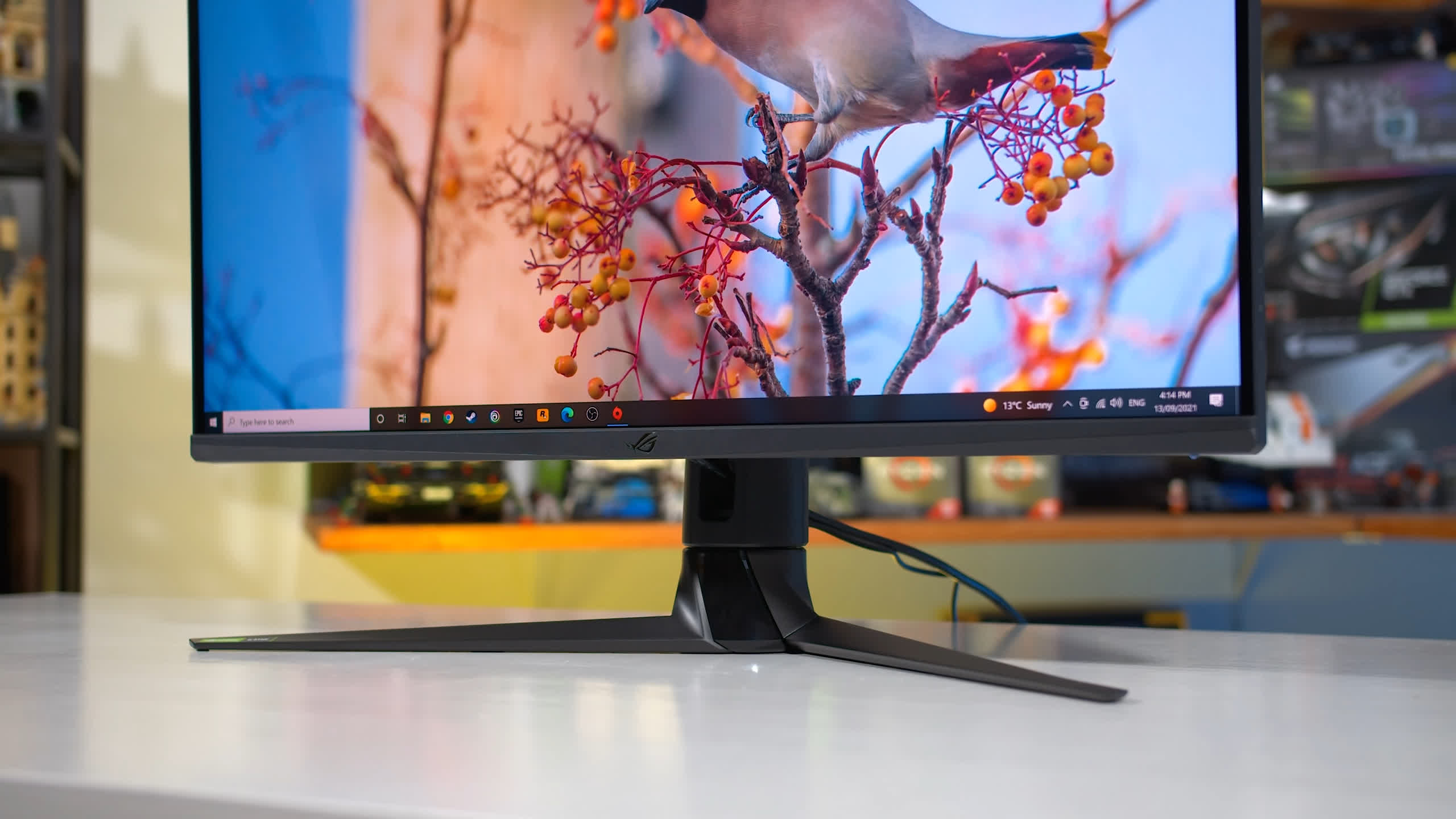
The stand is height, tilt and swivel adjustable, however information technology lacks pivot support so out of the box you can't use information technology in a portrait orientation, you lot'll demand a VESA mount for that. Height adjustability is okay, probably could practice with slightly more top, but at to the lowest degree you exercise get some adjustability there. In that location is no doubting the monitor is well built and the stand is sturdy.
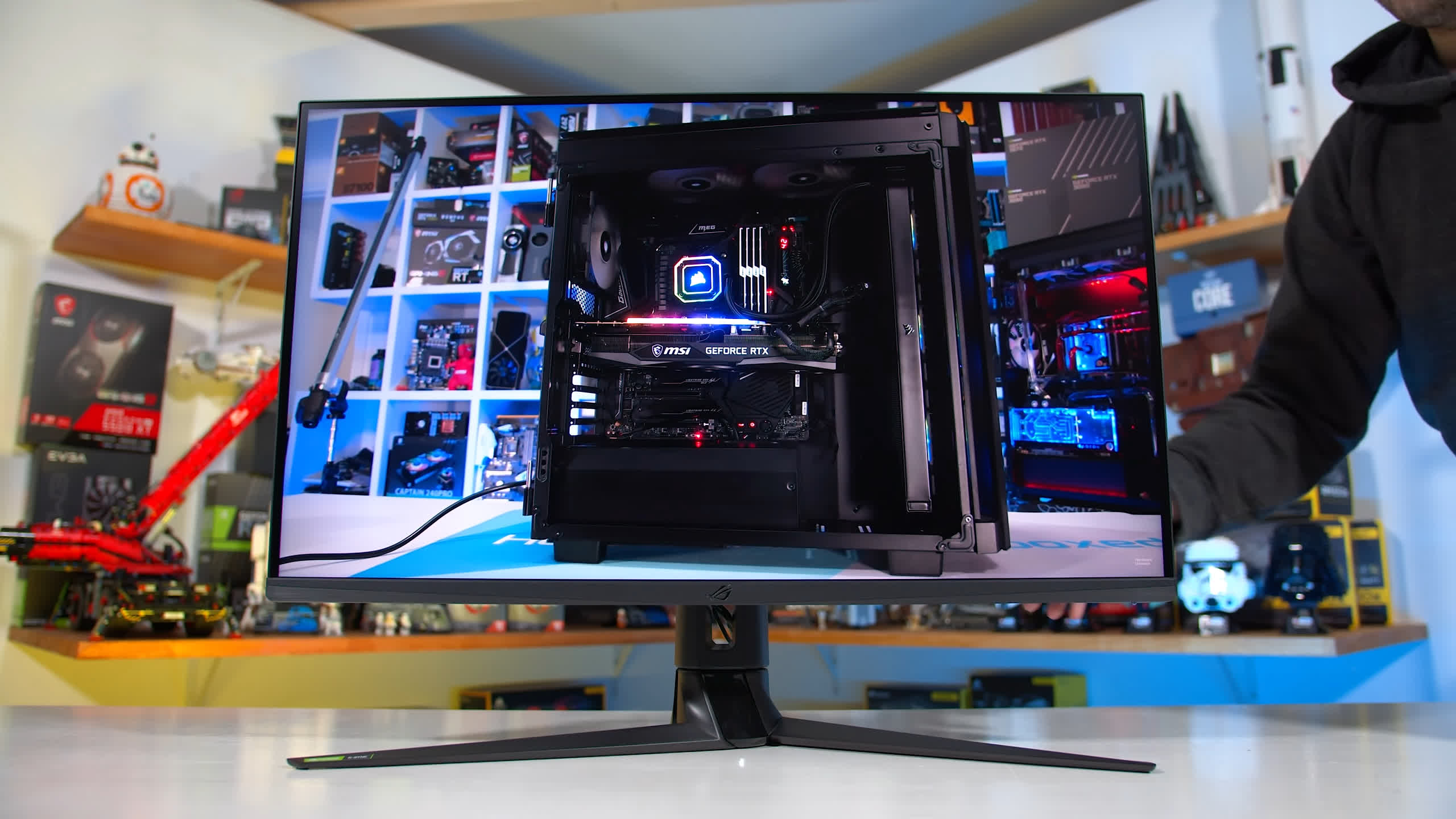
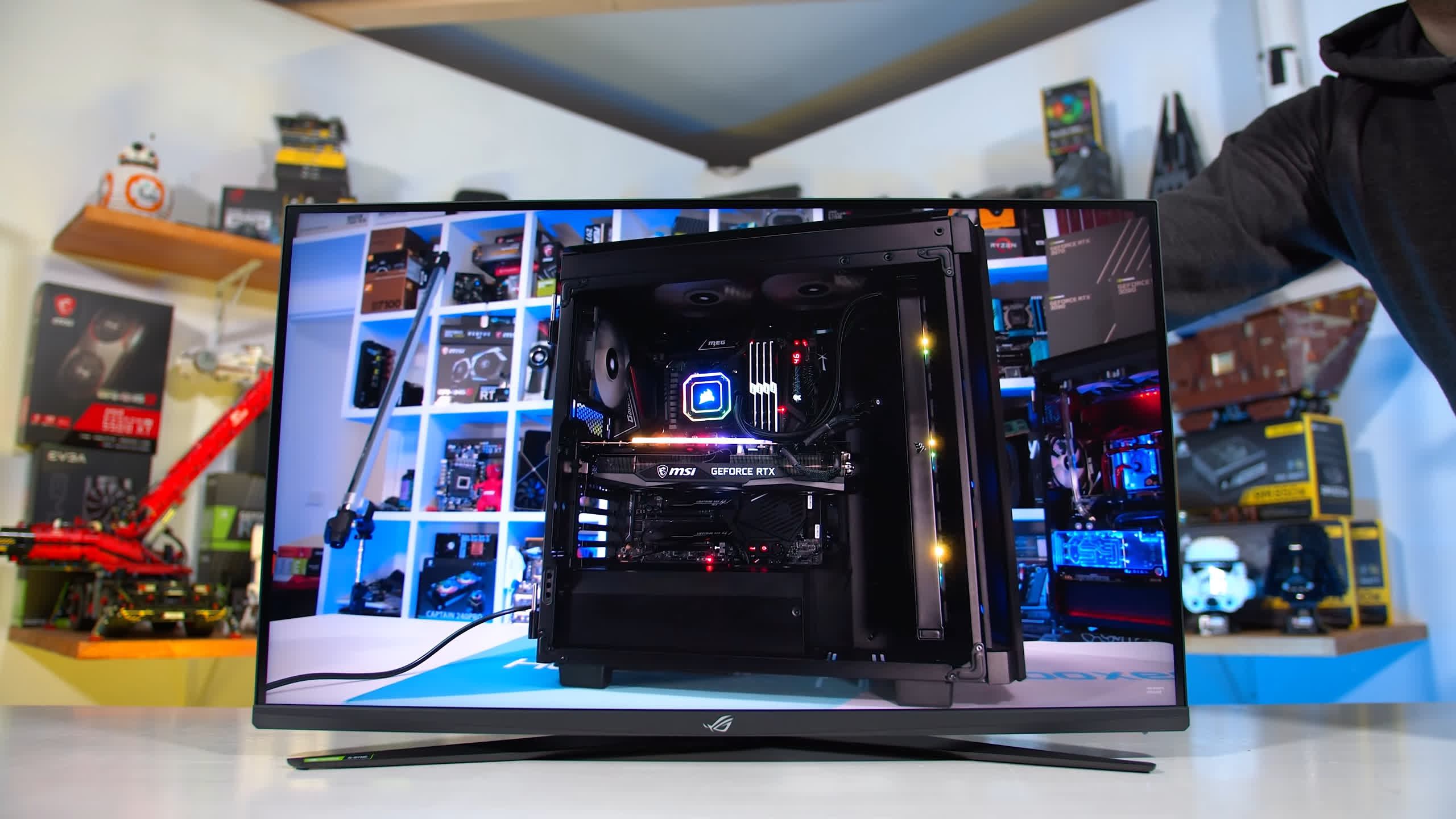
The OSD is controllable through the usual directional toggle. The carte du jour organisation is piece of cake to navigate and Asus packs in a lot of features here, from color controls to gaming stuff like crosshairs, timers, the sniper style, so on. Asus is one of the more than characteristic-packed brands for gaming monitor features and the PG32UQ is no exception.
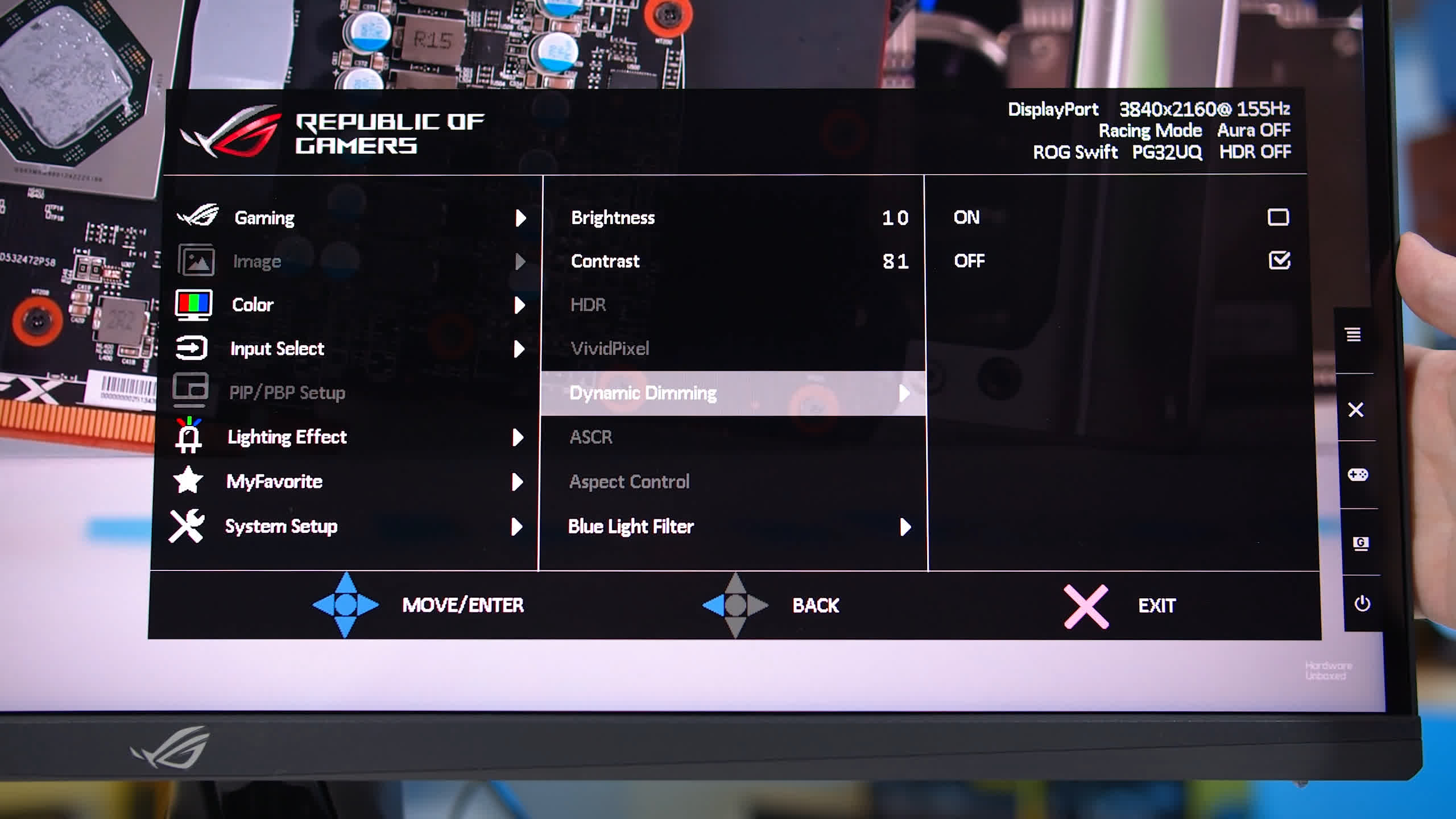
Display Performance
Although Asus lists this monitor topping out at a 144Hz refresh rate, the PG32UQ is actually a 155Hz display through an "overclocking" feature included in the OSD. We estimate Asus is segmenting out the 155Hz functionality into an OC manner considering non every brandish will exist able to do this in a stable fashion, and likewise some setups and cables might struggle with the slightly higher bandwidth requirements of that refresh rate at 4K. Our review unit of measurement seemed to work fine at 155Hz and in the past we've usually had no problems with OC features either, but simply a note that it may not piece of work properly with all models.



With that in listen, let'south get to testing response time performance at 155Hz across Asus included six overdrive modes, which are listed equally variable overdrive. Level 0 is finer overdrive disabled, and both Level 1 and Level two are quite like in that response times are slower than 10ms on average merely produce nigh no overshoot. You lot're probably not going to want to use any of these three modes for gaming.

Level three is one of two "most usable" modes in my stance. Hither we have a 10.3ms average response fourth dimension which isn't great and leads to low refresh rate compliance, only overshoot is basically non real here so it could be worth using. And despite somewhat tedious response times, cumulative deviation of 659 on boilerplate is really non that bad.

Then we get Level iv overdrive which improves functioning to an eight.88ms average response time and this only comes at the expense of a slight increase to overshoot. With cumulative deviation decreasing now to 624, this is the best overdrive mode we've tested so far and the ideal mode for gaming at 155Hz. Unfortunately though, this mode still isn't that fast and refresh compliance below 50% is disappointing, suggesting possibly the console isn't quite fast plenty for gaming at this refresh rate.

And so we become to Level 5 overdrive which is basically the mode Asus has to advertise fast response times. Yes the boilerplate response improves to 4.48ms, just the level of overshoot and inverse ghosting is pregnant and very obvious while gaming, making the way unusable.
With these results in mind I feel that Asus probably should have included a mode between Level 4 and Level 5 because nosotros become directly from a somewhat ho-hum mode with no overshoot, to a much faster mode with tons of overshoot. Something between these modes would have provided a meliorate remainder and could accept been optimal – maybe this brandish should have had a fully tunable overdrive slider?



For gaming beyond the refresh range, for example when using adaptive sync variable refresh rate functionality which is listed as FreeSync and Nvidia 1000-Sync Compatible, all modes I tested did include some course of variable overdrive. For case using Level 4, at that place'southward a noticeable step up in response times when shifting from 144Hz down to 120Hz. Nosotros're at present sitting at a six.84ms average response and that's only at the expense of some overshoot. However, some of those slow autumn times are however to be resolved.


And then as we move down the refresh rate calibration farther we go fairly similar results, until nosotros hit 60Hz where the Level 4 mode becomes a lot worse which is kind of disappointing. It seems like the variable overdrive tuning goes a bit overboard here at 60Hz and causes quite a lot of overshoot.





The other alternating option is to use Level 3 overdrive. This mode is a trivial chip slower at the summit terminate, but consistently has less overshoot, and at 100Hz and below actually has the lowest cumulative deviation value which suggests it produces slightly meliorate visuals. At that place is nevertheless a fall off in performance at 60Hz but this time it's much more manageable with less overshoot and then this is definitely the more than optimal mode to utilise at 60Hz.
Manifestly the question hither is whether the PG32UQ has a unmarried overdrive mode feel and to be honest I'g on the fence hither. The Level 4 mode is slightly better at higher refresh rates but information technology's not massively better and ultimately notwithstanding isn't that fast, yet it has bug at 60Hz. Meanwhile the Level 3 mode is pretty consistent, slightly slower than Level 4, but holds up well at lower refresh rates. I'd probably choose Level three for adaptive sync gaming and it sort of has a unmarried overdrive mode experience, just not a great unmarried overdrive manner experience… it's complicated. At the very least I think this display could be better tuned.

Compared to other displays, the Asus PG32UQ delivers disappointing response performance at its maximum refresh charge per unit, dare I say poor performance to exist honest. It'southward no better than the PG32UQX, which I slammed in its review for being slow and using outdated IPS engineering. The PG32UQ is simply not capable of the same operation as the best 4K displays of today, including the LG 27GN950 and Gigabyte M28U in the 27-inch class, or the Gigabyte FI32U which is a direct competitor to the PG32UQ at 32-inches. The FI32U does deliver more overshoot at the highest refresh rate, but it'south considerably faster and better tuned than the PG32UQ.

The PG32UQ also isn't impressive on average across the refresh range, despite using variable overdrive. The level of overshoot is low which is skillful to see, but it's still easily beaten past products like the 27GN950 and FI32U, although the FI32U lacks a single overdrive mode experience and has high levels of inverse ghosting at some refresh rates. Really neither the FI32U nor the PG32UQ deliver ideal response operation, which is frustrating as the experience with smaller 4K high refresh panels is a noticeable step better.

In cumulative divergence there is some positive news as we can ameliorate come across the balance betwixt response times and overshoot – and the PG32UQ is more towards the slow response, no overshoot cease of the spectrum. What'south good to see is that in this metric, the PG32UQ is clearly better than the slow PG32UQX, in fact it'south 19% better which is substantial. The not-X model is just that little chip faster to complete virtually of the transition, and does so with less overshoot, and so it benefits in cumulative deviation.
All the same on the whole, the PG32UQ is however not that amazing and falls behind IPS panels that appear to be using newer, faster technology. Again the 27GN950, VG28UQL1A and M28U are examples of this at 27-inches, and then for whatever reason I'k yet to come across that performance at a larger 32-inch size. The nearest equivalent to the PG32UQ is the Gigabyte FI32U and hither the FI32U is marginally better – 12% improve on average – but again neither of these displays are quite at the level I'd like from a mod high-end IPS monitor.


The fastest speeds you'll meet from the PG32UQ is at 120Hz, merely it's all the same not overly competitive with other 4K displays, though it does outperform the PG32UQX. At 60Hz it outperforms the PG32UQX by more and even beats the FI32U which suffers from a lack of variable overdrive, merely still fails to impress relative to other 4K 144Hz monitors that I've tested.

Input latency is low, with a processing delay below 1ms, indicating that nearly lag you'll become is from the moderate refresh charge per unit and slower response times. The FI32U is a step above here, and so of class for the all-time input lag you're better off with a 1440p 240Hz monitor in this cost class.

Ability consumption is equally expected. This display is 13% more efficient than the Gigabyte FI32U and a decent 35% more efficient than the PG32UQX, suggesting that dropping the mini-LED backlight and K-Sync module does indeed salve a scrap of ability and estrus output.

The PG32UQ does back up backlight strobing through ELMB-Sync, meaning information technology can be used with or without adaptive sync enabled. When it's used with adaptive sync, this is i of the better implementations I've seen from Asus, information technology looks like they've put some piece of work in here to reduce the mistiness that was in this mode previously. The PG32UQ all the same has some strobe crosstalk equally the panel itself isn't fast enough to keep up with the strobing, and y'all can't tune strobe length or brightness in this mode, but you can adjust the clarity position. This is handy because there's a limited range where you become the best clarity, in the default middle position there is a lot more crosstalk in the top and lesser sections of the monitor.
It's also adept to see the ELMB-Sync fashion concord up well at a range of refresh rates, with really no difference to clarity, if anything there's slightly less crosstalk at lower refreshes. The supported range here is 85 to 155Hz which is quite reasonable though lacking 60Hz.

You can too use ELMB without adaptive sync, the i divergence here being it unlocks the "clarity level" feature which controls strobe length (and therefore brightness also). The Level 5 manner is the near clear with the least mistiness and crosstalk, but besides the dimmest. At that place is no difference in clarity between ELMB and ELMB-Sync, with ELMB at Level v delivering basically the same results every bit ELMB-Sync which is good to run across.
The improvements made here to backlight strobing compared to other Asus monitors ways that I would recommend buyers at least experiment with this characteristic every bit information technology can reduce motility mistiness in some situations and overall I'd depict it as average to proficient. It'due south not a feature I'd recommend for everyone still, but it's swell on the PG32UQ and helps start some of the slower response times we've merely been talking well-nigh.
Color Functioning
Color Space: Asus PG32UQ - D65-P3
Next up nosotros take color performance the PG32UQ is an exceptionally wide gamut monitor. Non only do we get 95% DCI-P3 coverage, nosotros also get 100% coverage of the Adobe RGB color space, making this a highly versatile 4K brandish for content creators. The benefit hither is y'all could exist working on your wide gamut images or videos, then later on log off from work and start enjoying games at 4K 144Hz. That'southward the beauty of these sorts of panels, which in this case is providing a whopping 84% coverage of the Rec 2022 color space, college than nearly other panels on the market place and well above the Gigabyte FI32U.


Default Color Performance



When a panel has such a wide colour gamut, this introduces challenges for colour functioning. Out of the box color scale for greyscale is strong, with about no tint to the white point and reasonably good simply not perfect adherence to the sRGB gamma curve. However past default for regular sRGB or Rec. 709 content – which is the bulk of content today including nearly YouTube videos – the PG32UQ is hugely oversaturated. This is immediately obvious when using the display, and causes the "sunburn" event on skin tones where colors that should be pink to chocolate-brown are all shifted into the ruby-red zone.


You tin run across this play out in scale comparisons. Greyscale results are pretty good, in the upper portion of the chart, only ColorChecker results are totally inaccurate as the wide gamut is left unclamped by default.



Luckily for buyers, the PG32UQ does have a functional sRGB Way which is what I would recommend for using this display exterior HDR content. It has some limitations including locked white point controls, but greyscale functioning is okay, and the gamut clamp is constructive with a saturation deltaE ITP average of 3.25 and ColorChecker average of three.58. Information technology's not perfectly accurate but it's generally very good and far better than the default manner.
Calibrated Colour Performance





From here we can perform a calibration using Portrait Display's Calman software and the last results are splendid in most colour spaces. With full coverage of sRGB and Adobe RGB there are few issues with those gamuts, while P3 is missing the very top end of the color range so it isn't perfect merely still very good. This is 1 of those displays that works exceptionally well with calibration and could be used for productivity.

No issues with display effulgence as the PG32UQ is capable of 440 nits, higher than most monitors and sufficient for all types of indoor usage. Minimum effulgence though is non great, bottoming out at 82 nits and so it'south non the all-time brandish for usage in the dark.

I recorded quite a decent contrast ratio for an IPS panel with the PG32UQ, and this is without local dimming enabled, which is the default configuration. 1067:1 puts this monitor in the upper stop for IPS panels, like to most modern AU Optronics models and better than the Gigabyte FI32U. Even so, contrast is yet poor in general, as IPS panels are absolutely destroyed in black levels by VA panels and OLEDs.


Viewing angles are a non-issue with this display as information technology uses high-cease IPS engineering science, although my unit did suffer from moderately low IPS glow. Uniformity was okay, could be better though not the worst result I've ever seen and the majority of the panel looks reasonable in this area.
HDR Functioning
Wrapping up the testing nosotros accept HDR performance. The PG32UQ is a semi-HDR panel, because it meets ii of the 3 main criteria for HDR and has limited local dimming functionality. Brightness exceeds 600 nits which is what we desire to encounter, and the panel is capable of a very wide colour gamut. However the key area to HDR is contrast, and xvi border lit dimming zones is not sufficient for truthful HDR, though it will have some benefit over SDR in ideal conditions.


Sustained brightness is solid at a touch over 650 nits which is mid-range for an HDR panel, and obviously about half that of the PG32UQX. Similar brightness at a 10% window, so the PG32UQ appears to cap out at this brightness level. Indeed when measuring both peak and sustained brightness, I reported no difference at all, so the PG32UQ can't push up effulgence for short flashes either.

Contrast between two frames is perfect, then I won't show those results, as the PG32UQ can fully disable the backlight when showing a blackness frame. However if in that location is anything at all on the screen, then the backlight will enable and that limits the contrast ratio quite a bit in platonic scenarios. Basically rather than local dimming fully switching off the backlight for areas that should be black, the backlight is only dimmed to the everyman 'on' level, which has the issue of capping black levels and reducing the best case unmarried frame contrast to 16,000:one which is well below the minimum ideal target for HDR content.

Then for worst case HDR contrast in the checkerboard test you lot get native console performance as edge lit dimming is totally unable to dim small areas and therefore simply enables the backlight at all times. This operation is evidently not suitable for HDR and about a quarter of what y'all get from the PG32UQX. What this means is that in a large portion of HDR content that has circuitous areas that need dimming or brightening, the PG32UQ is unable to evangelize anywhere near an HDR experience

For HDR accurateness, greyscale tracking is mediocre for lower luminance values: anything below 30 nits is besides bright when displayed on the PG32UQ, and black levels (below 2 nits) are raised as well which seems to be an effect of the backlight not being able to dim itself enough. Basically the bottom v% of the HDR tone curve cannot be displayed at all on the PG32UQ in nigh situations as the minimum brightness level of the backlight is as well high, which leads to these raised blacks. Above 30 nits though, luminance tracking is good and roll-off around 650 nits is very skilful.



Saturation accuracy for BT.2020 isn't great despite covering a lot of this color space. P3 and Rec. 709 inside HDR are also a chip oversaturated, especially for greens, but not horrendous. Would have liked to see a fleck better accuracy here as this cannot be calibrated, simply given the rest of the panel's HDR functioning this is fine.
What Nosotros Learned
The Asus ROG Swift PG32UQ is the tertiary 32-inch 4K high-refresh gaming monitor we've tested, and the 2nd to occupy the $1,000 price bespeak after the Gigabyte Aorus FI32U. We establish the Gigabyte a little disappointing for the toll, it didn't quite accept the feature prepare that we look in this toll grade, and nosotros experience a like fashion with the PG32UQ.
In many areas the Asus delivers and information technology's a skilful gaming monitor, but it'south non quite in that location in terms of delivering the loftier-end experience we want.

With the ROG Swift PG32UQ it comes mostly down to response time performance. For a monitor released in 2022, the PG32UQ has previous-gen IPS response times, declining to get nigh the all-time on offering from this panel type today. This causes a fleck of ghosting, and while it does have variable overdrive – an abrasive omission from the Gigabyte FI32U – it just isn't that fast.
From our testing we tin can ascertain that top 27-inch 4K panels have better movement performance than any of the 32-inch variants released so far. Our hope was the PG32UQ would address this and give usa tiptop-end IPS speed at this size, but it doesn't. And while it isn't a super blurry brandish or annihilation similar that, there'south plenty of a difference to say it's noticeably slower than the FI32U it competes against.
And that's a shame because in most other areas performance is strong. This is a very wide gamut console which gives it great versatility for both gaming and content creation, especially handy at 4K and at this size, however it still has a decent sRGB mode for everyday use.
Contrast is pretty practiced for an IPS panel, as is brightness, and the backlight strobing mode through ELMB-Sync is improved on what Asus has been offering in the past and is going to be usable for some buyers. It also features HDMI ii.i, an embarrassing omission on the more expensive ROG PG32UQX flagship.
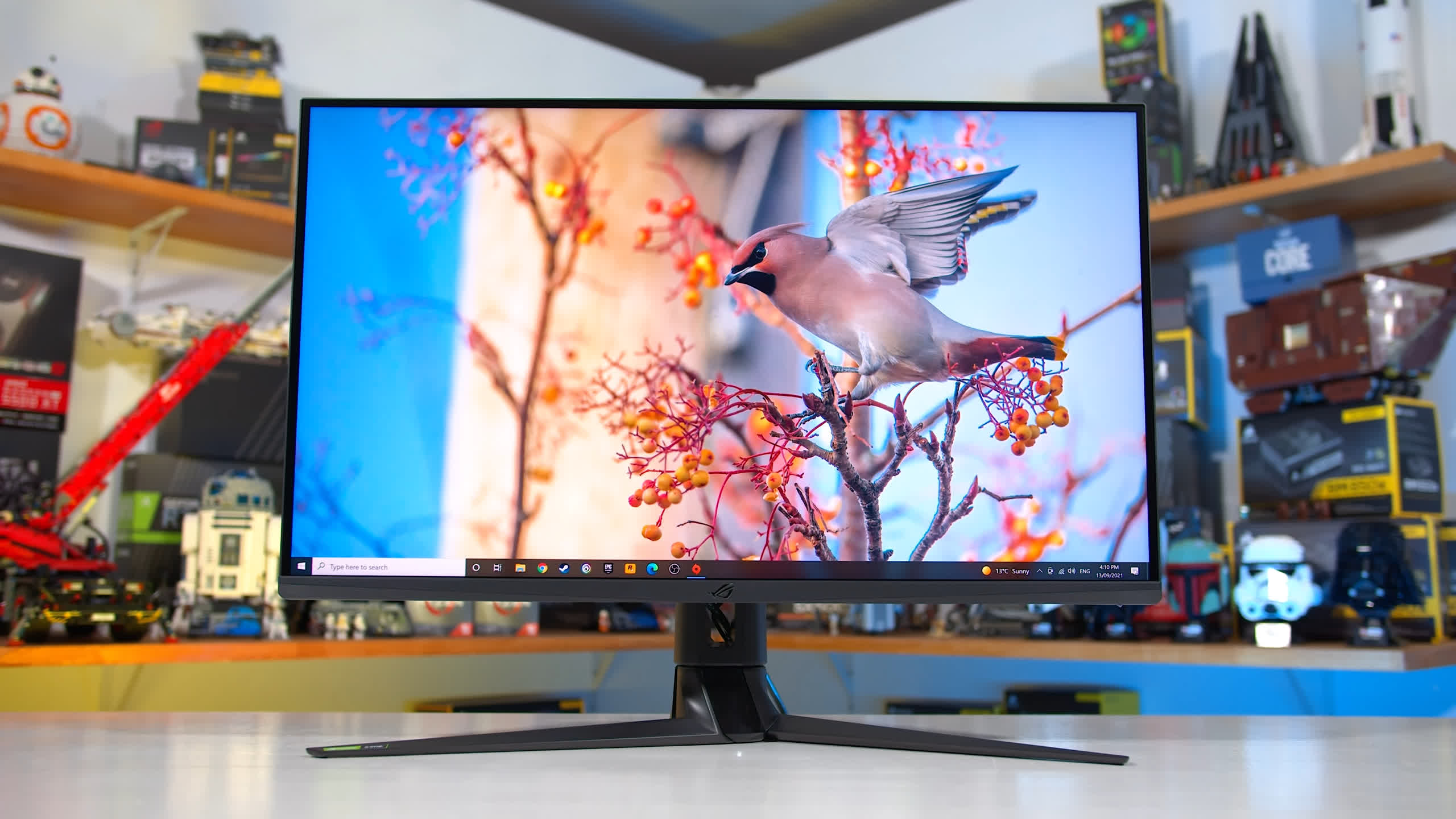
Would we recommend the PG32UQ? Honestly, information technology doesn't have the complete feature set we desire from a loftier-end, $1,000 gaming monitor, but we haven't tested whatsoever monitors with these specs that are significantly better either. Perhaps 1 exists, but of those we've tested we'd actually say the PG32UQ is sitting in the number i spot.
Yes, it'south slower than the Gigabyte FI32U, but it'south better at virtually other things. It has much better gamut coverage making it much more suitable for content creation, it has better semi-HDR functionality, better native contrast and superior backlight strobing. It also gets closer to having a single overdrive mode feel, despite mostly falling behind in response times. Of the ii, we'd choose the PG32UQ simply merely at a discount, and hopefully with more testing and newer releases nosotros'll find a 32-inch 4K monitor that is better.
Shopping Shortcuts:
- Asus ROG Swift PG32UQ on Amazon
- LG CX 48" OLED Telly on Amazon
- Asus ROG Swift PG32UQX on Amazon
- Gigabyte Aorus FI32U on Amazon
- LG 32GP850 on Amazon
- Samsung Odyssey G7 32" on Amazon
- HP Omen X 27 on HP Store
- LG 32GP850 on Amazon
Source: https://www.techspot.com/news/91472-asus-rog-swift-pg32uq-review-32-inch-4k.html
Posted by: arellanothavent.blogspot.com


0 Response to "Asus ROG Swift PG32UQ 32" Monitor Review"
Post a Comment